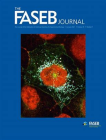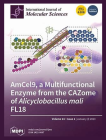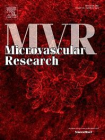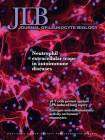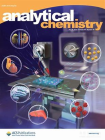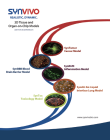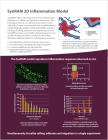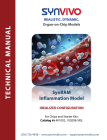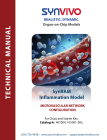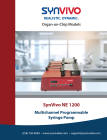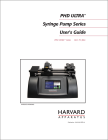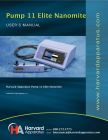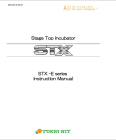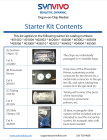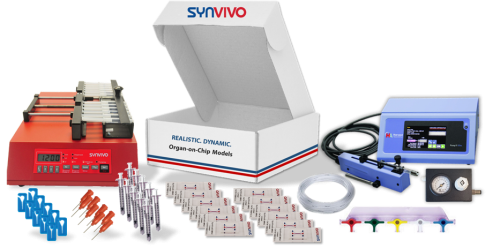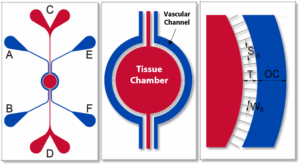
SynRAM Idealized Radial Chip

SynRAM Microvascular Network Chip
SynRAM™ delivers a physiologically realistic inflammation model (including flow and shear stress) and enables real-time visualization and quantitation of rolling, adhesion and migration processes in the leukocyte adhesion cascade. Key features of this model include in vivo-like microvascular morphology with fully formed lumenized blood vessels, physiological flow, co-culture capability for endothelial-immune cell interactions and quantitative analysis of rolling, adhesion, and migration data from a single experiment. SynRAM has been successfully validated against in vivo studies showing excellent correlation for rolling velocities, adhesion patterns, and migratory processes.
SynRAM inflammation-on-a-Chip model has been used to test drug or inflammation induced vascular injury, screen anti-inflammatory therapeutics and to model disease conditions like Sepsis and Acute Respiratory Distress Syndrome (ARDS).
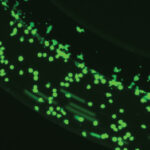
Real-time visualization of rolling, adhesion and migration
Real-time tracking of single-cell migration
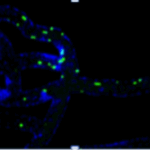
Leukocyte endothelium interactions
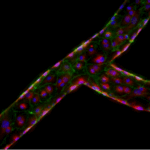
Vessel-on-a-Chip with endothelial cells
Applications and Assays
Inflammation-induced vascular leakage
Inflammation-induced biomarker analysis
Therapeutic drug screening
Screening for activators/inhibitors of inflammation
Publications using SynRAM models
Contract Research Services using SynRAM models
Model Inflammation, immune cell-endothelial interactions, test drug safety
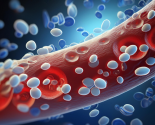
SynRAM Models Available
Monoculture using primary or iPSC derived endothelial cells
- Specific organ matched endothelial cells or HUVECs
Co-Culture with endothelial cells and stromal/tissue cells
- Lung microvascular endothelial cells and epithelial cells
- Brain microvascular endothelial cells and astrocytes/pericytes
Add immune cells to any model
Assays Available
Immune cell rolling, adhesion and migration across the endothelium
Inflammation-induced vascular permeability
Drug-induced vascular injury
Inflammation-induced biomarker analysis, cytokine profiling
Therapeutic drug screening
Screening for cell surface biomarkers
Target identification
Screening for activators/inhibitors of inflammation
Brochures and Technical Manuals
Videos
Purchase SynRAM Products and Instruments
Purchase starter kits, sets of chips, cells/cell lines, instrumentation and training workshops
SynRAM Starter Kit: Select this for your first-time purchase. All the basic components required to run SynRAM assays can be purchased in a kit format. The SynRAM starter kit includes 12 chips, tubing, clamps, needles, syringes, pneumatic priming device (required for seeding cells).
Cells/Cell Lines: SynVivo offers human cells and cell lines that have been tested and validated in the inflammation model.
SynRAM Chip Options: Depending on your specific research applications you can select from Idealized Network or Microvascular Network configurations.
Instrumentation: Syringe Pumps for cell seeding and maintaining flow based assays, stagetop Incubator and inverted microscope for real time visualization and quantitation of your Tumor assays
Training Workshops: SynVivo offers 2 and 4 day scientist-led training sessions. Gain hands-on experience with our organ-on-a-chip technology.
Starter Kits - Select your chip model
Important Note: Starter kit does not include required consumables such as cells, media, and matrix. Other required equipment not included is syringe pumps, cell seeding pumps, incubators, and microscopes.
Chip Model | CAT# | Product Name | Price | Qty | |
|---|---|---|---|---|---|
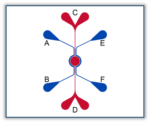 | 401002 | $2,100 | Max: Min: 1 Step: 1 | ||
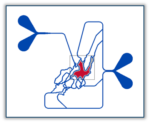 | 401004 | $2,500 | Max: Min: 1 Step: 1 |
SynRAM Model Chips
Chip Model | CAT# | Product Name | Price | Qty | |
|---|---|---|---|---|---|
 | 102008-SR3 | $375 | Max: Min: 1 Step: 1 | ||
 | 105001-SR3 | $499 | Max: Min: 1 Step: 1 |
Human Cells/Cell Lines
CAT # | Product Name | Price | Qty | |
|---|---|---|---|---|
Syn-10HU-003-CR10M | $141 | Max: Min: 1 Step: 1 | ||
Syn-10HU-003-CR350M | $894 | Max: Min: 1 Step: 1 | ||
Syn-10HU-003-CR5M | $78 | Max: Min: 1 Step: 1 | ||
Syn-10HU-003-P | $197 | Max: Min: 1 Step: 1 | ||
Syn-CXPR-15-1200M | $2,020 | Max: Min: 1 Step: 1 | ||
Syn-CXPR-15-200M | $1,006 | Max: Min: 1 Step: 1 | ||
Syn-10HU-009-20M | $872 | Max: Min: 1 Step: 1 | ||
Syn-10HU-008N-10M | $1,086 | Max: Min: 1 Step: 1 | ||
Syn-10HU-024N-5M | $599 | Max: Min: 1 Step: 1 |
Training Workshops
CAT# | Product Name | Price | Qty | |
|---|---|---|---|---|
SYN48 | SynVivo On-Site Training Workshop – 2 days | $2,750 | Max: Min: 1 Step: 1 | |
SYN96 | SynVivo On-Site Training Workshop – 4 days | $4,500 | Max: Min: 1 Step: 1 |
Syringe Pumps - Instrumentation for Seeding cells and maintaining Flow based assays
Image | CAT# | Product Name | Price | Qty | |
|---|---|---|---|---|---|
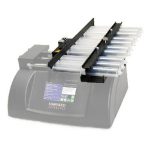 | 301004 | PHD Ultra 6/10 Multi Syringe Rack | $920 | Max: Min: 1 Step: 1 | |
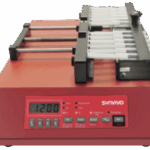 | 301020 | Multichannel Programmable Syringe Pump – SynVivo NE 1200 | $2,100 | Max: Min: 1 Step: 1 | |
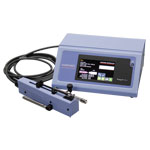 | 301002 | Pump 11 Elite Nanomite Infusion/Withdrawal Programmable Single Syringe | $3,790 | Max: Min: 1 Step: 1 | |
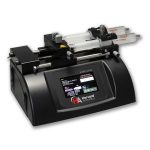 | 301003 | PHD Ultra Syringe Pump Programmable 2-Syringe Rack Standard Pressure | $5,651 | Max: Min: 1 Step: 1 |
Tokai Hit Stage Top Incubator
Image | CAT# | Product Name | Contact Us |
|---|---|---|---|
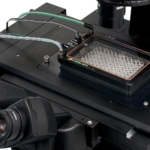 | 303015 | ||
 | 303016 | ||
 | 303017 |

